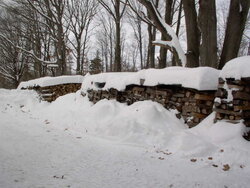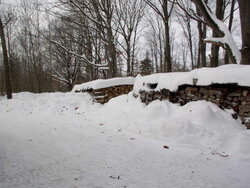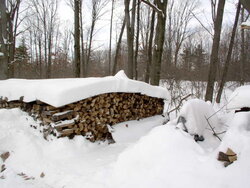It must be true...my oak will be seasoned in no time flat. 1 to 2 years. I like this answer better than 3 years. 
http://www.wikihow.com/Season-Firewood

http://www.wikihow.com/Season-Firewood




"Importantly, there isn't any point seasoning wood longer than it needs to be. Over-dried wood will have less energy as volatile esters in the wood evaporate. These waxy substances contain a great deal of heat energy, so it is a mistake to think that longer is necessarily better."Was Dennis aka Backwoods Savage the author? If not then we still have to wait 3 years for oak.

Just checked, and the Cornell article was done in '74. You are correct, clemsonfor, it was an old study.Yea hickory is full of water!! That stuff will sizzle like crazy.
This stuff was prolly most likely done in the 70-80s before the modern stoves existed. Burning and drying techniques were different. Wood still burned the same but knowledge was diffent.
"Wood such as shagbark hickory, cherry and black locust will gain little benefit from air drying, as they have low moisture content." I did not know that....
Pretty sure that if I toss some three-month Black Cherry or six-month Hickory into the stove, it'll be sizzling like bacon....
"Importantly, there isn't any point seasoning wood longer than it needs to be. Over-dried wood will have less energy as volatile esters in the wood evaporate. These waxy substances contain a great deal of heat energy, so it is a mistake to think that longer is necessarily better."
I'm guessing Dennis had nothing to do with this article.
I'm starting to think that Oak may be two-year wood around here if split medium (6" max,) but the jury is still out. Got some stacked double-row, so we shall see....

Yeah, but just think how great it would burn if it still had all those volatile esters!For sure it is not necessary to keep wood longer but to think it does not burn good after keeping for several years is totally wrong. Quite the contrary, it burns really sweet and gives some really good heat too.
 I'd like to know a percentage; How much difference are we talking about here?
I'd like to know a percentage; How much difference are we talking about here?




volatile esters!

I don't think it can dry any lower than equilibrium, but that may vary depending on if it's summer or winter. The raw meter readings also need to be adjusted for different species. Could be that you had the heat blasting in the car, since you like it hot in the house.I've never checked any of our wood. However, that wood was checked at Woodstock and there were a few different readings. I remember one at 8% and another at 11% but don't recall what the others were except they were super low. So much for the wood not drying below what the humidity is....
 Or you took wood from the barn, where it was hotter. I don't recall you mentioning where the wood was from but maybe I missed it? Anyway, the EMC concept makes sense to me but YMMV.
Or you took wood from the barn, where it was hotter. I don't recall you mentioning where the wood was from but maybe I missed it? Anyway, the EMC concept makes sense to me but YMMV.I don't think it can dry any lower than equilibrium, but that may vary depending on if it's summer or winter. The raw meter readings also need to be adjusted for different species. Could be that you had the heat blasting in the car, since you like it hot in the house.Or you took wood from the barn, where it was hotter. I don't recall you mentioning where the wood was from but maybe I missed it? Anyway, the EMC concept makes sense to me but YMMV.
I think that ideally, I'd like to burn wood that was at 16-18%, a bit higher than the EMC here. But if you want to get years ahead, like I do, the wood will probably end up drier than that. So be it.




